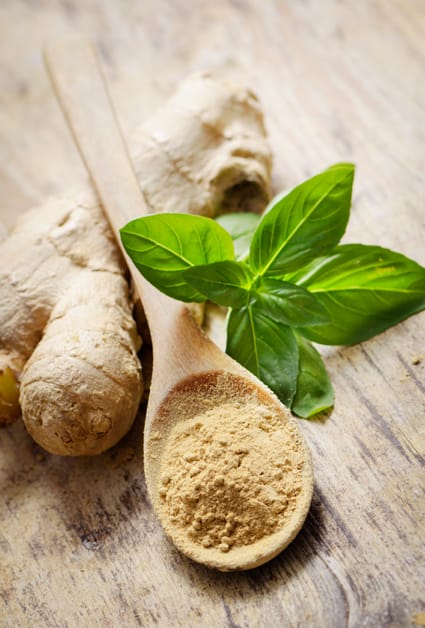Introduction
Ginger is strong and anti-inflammatory! People have used it for ages for its healing abilities. Studies in traditional medicine have proven that ginger can reduce pain and inflammation in the body. It is particularly useful in relieving knee pain and inflammation, which can arise from different causes. In this article, we will explore how ginger can help with knee pain and inflammation.
Overview of ginger
Ginger, or Zingiber officinale, is a flowering plant in the family Zingiberaceae. Its root is used as a cooking spice, and a traditional medicine. People have used it for thousands of years to relieve stomach upset, nausea, and morning sickness. It also helps reduce inflammation, cholesterol levels, pain, and improves circulation.
You can consume ginger in different forms, such as
- fresh or dried root
- ground powder
- powdered extract
- capsule
- tea
Besides using it as a medicinal remedy or spice, you can add it to juices and smoothies. The root has an aromatic, unique flavor that goes well with other herbs, spices, and drinks.
It’s important to remember not to consume too much ginger, as it might cause stomach upset for some people.
Why ginger is beneficial for knee pain relief
Ginger is used for its flavor in cooking and health benefits. It has anti-inflammatory properties that can reduce knee pain. Studies found active compounds like gingerols and shogaols, that can lessen pain and swelling of conditions such as osteoarthritis, rheumatoid arthritis and tendonitis.
The compounds block substances that cause inflammation and reduce pain-causing cytokines and prostaglandins. Ginger also stops enzymes that break down cartilage. It is an antioxidant, which helps protect joints from damage caused by inflammation and oxidation.
Ginger’s minerals like manganese, calcium, magnesium, potassium and zinc support healthy joints and tissues. Plus, it has vitamins like folic acid and B6 to help with collagen production.
Ginger can be consumed fresh or in powdered form. People can add it to food or drinks like tea or smoothies. It comes in supplement form too, like capsules or liquid extracts, to take daily for treatment.
Nutritional Benefits
Ginger is amazing! It’s been used for centuries to relieve pain and inflammation. Recent studies show it powerfully helps reduce knee pain in those with arthritis and other chronic conditions. Here we’ll dive into the amazing nutritional benefits of ginger for knee pain relief.
Vitamins and minerals found in ginger
Ginger is a fragrant root, used in cooking and traditional medicine for ages. This dynamic spice is full of vitamins and minerals, making it a helpful addition to any diet. Ginger root has many minerals, such as calcium, iron, magnesium, phosphorus and potassium. It also offers vitamins B1-B6, C and E.
Apart from these strong vitamins and minerals, ginger has various other essential health benefits.
- Ginger has gingerols, which are anti-inflammatory compounds. These can help reduce the intensity of arthritis symptoms, like swelling or tenderness in the joints.
- Many studies have proved that ginger has remarkable benefits for digestive health. It can lessen nausea linked to motion sickness or pregnancy. Ginger can also boost appetite and enhance digestion, by raising the production of saliva and gastric juices in the stomach.
- Lastly, ginger is thought to be useful for controlling blood sugar levels. It can help with weight loss, especially when taken before meals or after eating sugary snacks. This is due to its capability to slow down the absorption of sugar into the blood stream.
Anti-inflammatory properties of ginger
Ginger is highly praised for its anti-inflammatory properties. Studies have shown its ability to reduce inflammation, especially that of the knee due to osteoarthritis. Its bioactive compounds, such as gingerols, shogaols and paradols, possess anti-inflammatory and pain-relieving effects.
Taking ginger orally or applying it topically stimulates the release of melatonin and serotonin in the brain. This helps to block pain signals. The gingerols also act as an antioxidant, counteracting oxidative stress from inflammation. Some components of ginger may even slow down cartilage damage in the joint due to its high antioxidant content.
Ginger’s power to lessen pain is likely linked to its effects on enzymes which break down proteins causing inflammation, like cytokines and prostaglandins. Studies have found that consuming ginger decreased joint stiffness and disability in those with knee osteoarthritis, more so than those taking a placebo.
Internally (in capsule form) or externally (as an ointment), ginger can be a great anti-inflammatory supplement for chronic knee pain due to degenerative conditions or wear and tear over time.
How to use ginger for knee pain relief
Ginger is a great anti-inflammatory. It can help reduce knee swelling and inflammation. Plus, it offers lots of antioxidants. These help strengthen your immune system. Here, let’s look at the best ways to use ginger to ease knee pain. There are lots of methods, and potential benefits too.
Oral consumption of ginger
Ginger is a popular way to treat knee pain. It comes in many forms: fresh, dried, powdered, and tinctures. Gingerol in fresh ginger has an anti-inflammatory effect, reducing swelling and stiffness. Consume one teaspoon of fresh ginger daily for relief.
Make ginger tea for added therapeutic benefits! Boil one teaspoon of fresh ginger for 10 minutes, strain and drink 1-2 cups daily before meals. Get creative with other healing herbs like turmeric, lemon balm, or licorice. Add raw honey or coconut milk for flavor.
Topical application of ginger
Ginger is good for knee pain. It works best if you use fresh ginger root – one tablespoon’s worth. Grate it into a bowl. Then, put it on a clean cloth or the painful area. Wrap with a bandage or elastic wrap. Leave it on for an hour. Discard the used ginger pieces.
Ginger’s anti-inflammatory compounds help reduce joint pain and swelling. Do this two to three times a day until your pain goes away. Also, drink ginger tea several times a day. This can help with the relief of knee pain.
Other Benefits
Ginger has anti-inflammatory properties and reduces muscle pain, so it is thought to help with knee pain. But did you know it has other advantages too? Here are some of them:
- Ginger can boost your immune system, improve heart health, ease nausea, and aid digestion.
- Plus, it can reduce menstrual pain and lower blood sugar levels.
- Finally, ginger can improve brain health and reduce inflammation.
Other health benefits of ginger
Ginger is not only great for relieving knee pain, but it has many more health benefits. It’s been used for centuries to treat digestion issues, nausea, and inflammation.
It helps reduce cholesterol, and studies suggest it can help people with type 2 diabetes by raising insulin sensitivity and lowering insulin resistance. Plus, it may reduce oxidative stress.
Ginger also boosts oral health due to its antibacterial properties. And it can reduce headaches, muscle pain, and menstrual cramps. Plus, it may even have cancer-preventing qualities.
Add this powerful root to your daily diet or apply its oil to sore areas of your body. You’ll be making a great investment in your health.
Potential side effects of ginger
Ginger is a root that dates back to ancient times and is used in traditional medicine, cooking, and beverages. It has compounds that fight common symptoms like nausea, upset stomachs, and headaches. Yet, too much ginger can cause problems. For instance, it can cause heartburn or intestinal gas. It may increase the risk of gallstone attack for people prone to it. People with diabetes should be careful – it could lower blood sugar levels, leading to hypoglycemia.
Pregnant women should talk to their doctor before taking ginger. It might increase the risk of premature labor. Therefore, it is better to consult healthcare professionals instead of self-treating with ginger if you are trying to conceive.
Conclusion
Ginger offers several health benefits! It’s great for decreasing knee pain and swelling. It’s simple to incorporate ginger into your diet. You can add it to a range of dishes and drinks. Utilizing ginger in your meals is a natural way to ease knee pain and inflammation.
This article has discussed how ginger helps with knee pain relief:
- Adding ginger to meals and drinks.
- Utilizing ginger as a natural way to ease knee pain and inflammation.
Summary of ginger’s benefits for knee pain relief
Ginger is an herb with many health benefits. Its power comes from gingerols, which are active compounds that have powerful anti-inflammatory effects. Studies show that when eaten as part of a diet or taken as a supplement, ginger can reduce knee pain and stiffness caused by medical conditions like osteoarthritis, rheumatoid arthritis and gout.
It can also assist with muscle soreness, post-workout inflammation and joint pain caused by long-term exercise or overuse. Research suggests that ginger can reduce inflammatory markers in the body, providing a natural way to manage knee pain without medication.
Ginger is also popular for its flavor and uses in the kitchen. You can add fresh or supplement forms of ginger to smoothies, soups and recipes to help reduce muscle soreness and joint discomfort after physical activity. You can also get the benefits of ginger through:
- Capsules
- Extracts
- Teas
- Other beverages
Tips for incorporating ginger into your diet
Ginger is a tasty and nourishing addition to any diet. It has been used in traditional medicines for centuries to treat many ailments. And, its anti-inflammatory properties are great for those with joint pain.
Adding ginger to meals or snacks is a fun way to add flavor and nutrition. Here’s how to make it happen:
- Stir-fry or cook dishes with fresh ginger. Grate it over meat, fish, and poultry. And, it goes great with garlic, onion, green onion, cumin, and tamarind.
- Use ground dry ginger in cookies and breads. This type of ginger has a deeper, spicier flavor. It works well with cardamom, cloves, cinnamon, and nutmeg.
- Make herbal teas with fresh or dried ginger roots. Boil slices of fresh ginger (or 1 teaspoon of minced dried ginger) in water. This tea can soothe throat or digestive issues and provide antioxidants, vitamin B6, A&C & E, and potassium. Add honey or lemon juice for extra flavor.
Frequently Asked Questions
Q: What makes ginger a powerful anti-inflammatory food?
A: Ginger contains gingerol, an anti-inflammatory compound that has been proven to help reduce pain, inflammation, and swelling in the knees.
Q: How can I add ginger to my diet?
A: You can add ginger to your diet by adding it to smoothies, juices, salads, soups, and stir-fries. You can also make a ginger tea by boiling fresh ginger root in water for 10 minutes and then straining it.
Q: How much ginger should I consume for knee pain relief?
A: It is recommended to consume 2-4 grams of ginger per day for knee pain relief. It is best to consult with your doctor to determine the right dosage for your individual needs.





